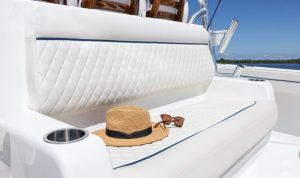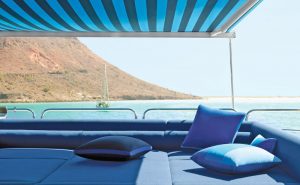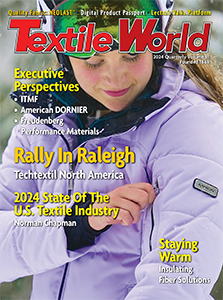
Marine fabrics, combining durability with aesthetics, influence and are influenced by partner and peer industries.
By Anne Bushell
Marine fabrics play a specialized yet defining role within the textile industry. First and foremost, they’re designed for resiliency and durability, so some of the most cutting-edge performance innovations show up in this space first. And when it comes to aesthetics, marine textiles serve a wide range of style needs, from sporty power boats to recreational pontoon boats to high-end yachts needing the most elevated designs.
The trends and positioning within the marine textile space can signal larger evolutions on the horizon for all fabrics. From trending colors and textures to technological advancements, there’s no shortage of exciting developments for 2025 and beyond.
When predicting how marine textile design will evolve in both the near and long term, there are a few key indicators that inform a forecast. Developers look to partners, peer industries and evolving cultural behaviors and preferences to understand the larger-scale influences that may affect the look, feel and style of the marine industry. The Sunbrella design team keeps a close eye on the industry through trade shows, consumer feedback and marine influences seen while traveling. Perhaps the most valuable resource is the relationships with partners and customers. Sunbrella keeps an ongoing dialogue to understand what they’re hearing from their customers, where their needs are and how it can provide even better, more beneficial products to them. The global design and research team that develops fabrics for a wide range of applications at Sunbrella has a multifaceted understanding of the textile industry and the nuances of specific fields.
Peer Industry Influences
One industry with a broad influence on marine design is automotive design. Some specific automotive trends influencing the marine sector include the rise of mid-tone neutrals such as shades of putty and mid-tone blues. When it comes to hardline elements, trends show movement toward flatter paints in place of pearlescent finishes. Ultra-matte paints are in growing demand, especially for high-end cars and boats.
Beyond automotive, other industries — big and small — can have a meaningful impact on marine design. Even in an area as niche as wrist-watch design, the ways the hardware, leather band and watch face details are intricately paired together for a big impact can spark inspiration for new material pairings on a boat.
Take sports apparel, from shoes to activewear, as another example. The color palettes in this industry are meant to paint a picture of functionality, with softer colors used for everyday life but added pops of color through trim or labeling that are meant to communicate the product is meant for a sportier purpose.
While these exact textures or pops of lime greens and sporty reds may not make it directly onto most boats, this principle influences how all boats are designed. At boat shows in the past, there were more solid, plain approaches to seating, but boat shows are now filled with intricate seating details, from quilted finishes to pops of color.
Interior design and its tenets can lend inspiration to the marine market as well, particularly when it comes to a cohesive palette for the full boat design. Interior designers take a holistic approach to a room, considering how the drapery, rugs, seating and throw pillows all relate to one another. Even in a more industrial application, Sunbrella can think like its peers in the décor area to create a more impactful product. Holding frequent one-on-one consultations with OEMs and fabricators can help lend a new perspective to the design processes. It seems like this interiors-infused approach is on the rise and will continue in the years ahead.

The Rise Of Texture
Technological advances have allowed for significant movement in what’s possible in performance upholstery fabrics, including bouclé and chenille yarns that maintain performance attributes. This texture-forward approach extends to more industrial design as well, and while the marine fabric industry doesn’t have these decorative yarns to work with, it has other creative ways to imbue texture into these palettes, including embossing patterns or new weaving structures. More and more, textures layered throughout the boat with complementary colors and finishes are observed. Rather than a full helm chair in a bold texture, fabricators are bringing in strong texture through piping details to add even more depth. Texture can convey a story in boaters’ minds, even if they don’t realize it, such as a perforated look signaling a high-tech breathability or a leatherlike finish reading as a more luxurious fabric.
As marine design trends move toward these neutral, less lustrous palettes, expect an even heavier reliance on textile elements to add depth and dimension, especially as a way to subtly elevate the boat design.
Next-Level Performance And Comfort
Marine textile performance elements are non-negotiable due to the harsh conditions on the water. Marine textiles must retain their color through ultraviolet (UV) exposure and be resistant to water, mildew and microbial pinking, and that performance should be backed by a comprehensive warranty. How-ever, superior performance shouldn’t compromise the importance of comfortable fabrics that help make a boat look and feel luxurious.
Ultimately, comfortable fabrics lead to a more pleasant boating experience that allows boat owners to stay out on the water longer. That means a continued interest in pop-up shade structures and a focus on fabrics that create a more comfortable ride even when bracing for impact over choppy waters. As the aesthetic elements of marine textiles evolve, designers and product development teams are working hand-in-hand to make sure they not only maintain their performance attributes but also improve them to make for an even better experience on the water.
An Increased Emphasis On Sustainability
Now also is the time to reinforce the importance of sustainability in marine design. When looking to other elements of the boat, electric motors are beginning to enter this industry in full force, and other sustainable elements are beginning to be incorporated in boat design, including biodegradable boat wraps.
When it comes to marine textiles, recycled content continues to be introduced into fabrics. It’s become much more common in décor fabrics and even in some of the canvas fabrics seen on boats, but reclaimed fibers are starting to be included in more industrial fabrics as well. Even the sheer quality of marine textiles is inherently a question of sustainability, as the more durable, long-lasting, warranty-backed options will require less frequent replacement and con-tribute less waste over time.
Per- and polyfluoroalkyl substances (PFAS) chemicals are also a hot topic when it comes to performance fabrics and their impact on the environment, especially as state and federal bodies begin regulating these chemicals more and more. Some brands, such as Sunbrella, have been shifting to non-PFAS production backed by years of research to ensure minimal impact on the performance capabilities of the fabric.
Powered By Innovation
Anchored in innovation, marine textiles are an essential part of the broader textile industry, with technology and design changes set to reverberate across industrial fabrics and beyond. As recreational boating grows and as the marine market continues to influence and be influenced by partners and peer industries, the innovations and design trends in marine textiles will keep making waves.
Editor’s Note: Anne Bushell is design director of product development, Sunbrella, Burlington, N.C.
2024 Quarterly Issue IV




